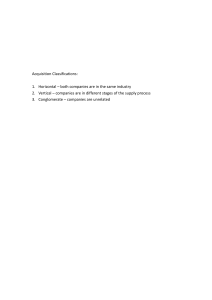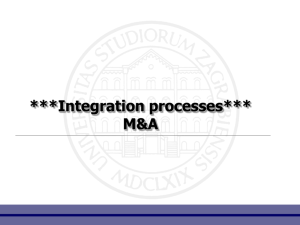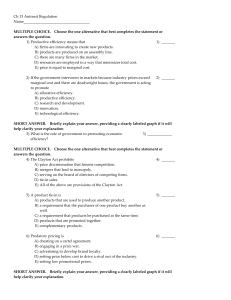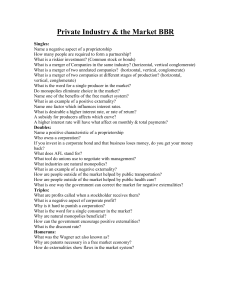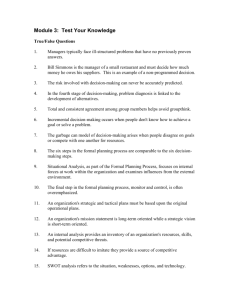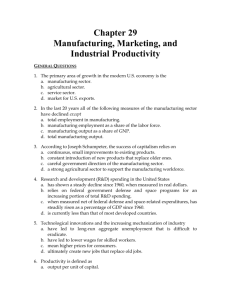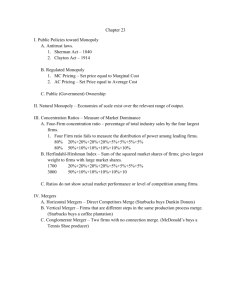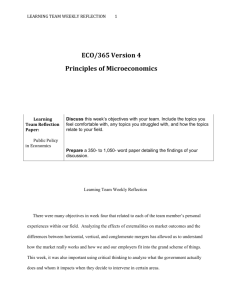Integrations
advertisement
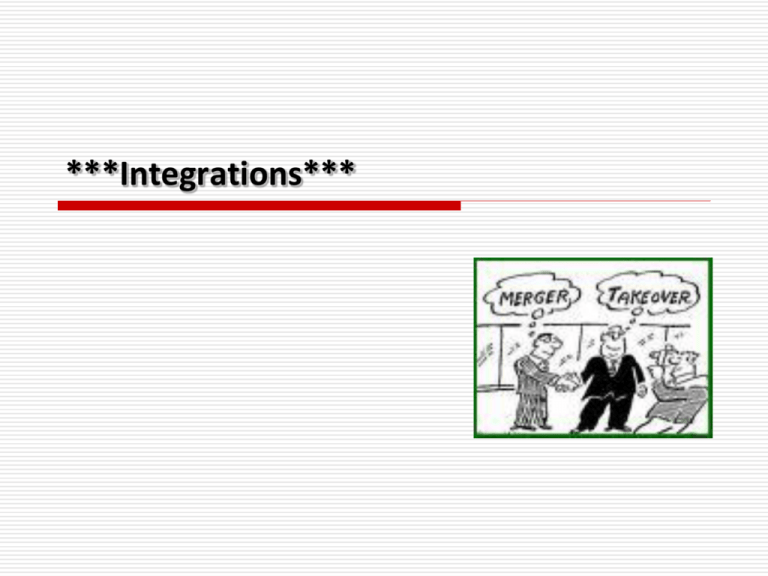
***Integrations*** Topics covered by the lesson: Business level strategy Corporate level strategy Strategies for firms in foreign markets Mergers and acquisitions Examples… Strategic management process Corporate mission and goals Internal analysis External analysis Strategic choice Corporate level strategy Business level strategy Portfolio analysis and entry and exit strategies Choosing organizational structure Conflicts, Politics and Change Matching Strategy, structure and controls Feedback Choosing organizational controls Corporate level strategy 1. 2. 3. 4. 5. Stable growth Growth - Concentration on a single product or service - Concentric diversification - Vertical integration - Horizontal integration - Conglomerate diversification Endgame strategies Retrenchment - Turnaround - Divestment - Liquidation Combination Business level strategy 1. Overall cost leadership – emphasizes producing and delivering the product or service at a low cost relative to competitors, while not neglecting quality or service 2. Differentiation strategy – requires a product or service that is recognized industry wide as being unique, thus permitting to charge above average prices 3. Focus strategy – involves concentrating on a particular group of customers, geographic markets or product line segments in order to serve narrow market better than competitors serve broader market GROWTH Corporate level strategy-explained Horizontal integration - Growth trough the acquisition of one or more similar firms operating at the same stage of the production chain (competitors) ADV: - Eliminate competitors and provide the acquiring firm access to new markets expl. MOL-Tifon - Economies of scale and increasing efficiency of capital use - Moderately increased risk as the success of the expansion usually depends upon proven abilities RISK: Increased commitment to one type of business GROWTH Corporate level strategy-explained Vertical integration - Growth trough acquiring firms that supply original firm with inputs or are customers for its outputs - Backward – move into supplying products and services used in production - Forward – move towards distribution of own products - Reasons: decreasing dependability of the supply or to take control over sales or distribution channels Raw material Intermediate Manufacturer Assembly Distribution Retail Vertical integration Value is added by: - production cost savings (production processes carried out in quick succession) - avoidance of market costs (no buying/selling costs) - better quality control - protection of proprietary technology Disadvantages: - cost disadvantages (commitment to certain supplier or retailer) - technological change - demand uncertainty GROWTH Vertical and horizontal integrations Textile producer Textile producer Shirt manufacturer Shirt manufacturer Clothing store Clothing store Acquisition or merger of competing businesses – HORIZONTAL integration Acquisition or merger of suppliers or customer businesses –VERTICAL integration GROWTH Concentric diversification – departure from firm’s existing base of operations, typically by acquisition of a separate business with synergic possibilities counterbalancing the strengths and weaknesses of the two businesses – example Head - in concentric diversification products and services added must lie within organization’s know how, experience in technology, distribution channels or customer base - Difference among horizontal integration and concentric diversification – horizontal integration aims at competitors GROWTH Conglomerate diversification - - Growth pattern based on the most promising opportunity available (little attention given to creating product-market synergy with the existing businesses). Reasons: balance in portfolio, better access to capital, synergy Possible forms: product conglomerate, geographical conglomerate, pure conglomerate Joint ventures - - - Separate corporate entity jointly owned by two or more organizations One organizational form for achieving organizational objectives that neither organization could normally attain acting alone Reasons for entering joint ventures: formal restrictions, economies of scale, risk sharing, access to resources Mergers & acquisitions Methods used for previously mentioned strategies MERGER – two companies combine their operations creating a third company (A+B=C) Extensive organisational changes ACQUISITION – one company buys and controls other company (loss of economic independence; still separate legal entity) M&A can be in the following forms: - horizontal - concentric - vertical - conglomerate Reasons for M&A - market value of stock of both firms - better utilization of existing manufacturing facilities - Smoothing out present cyclical trends in present products or services - Providing resources for expanding the organization - Securing a source of raw materials - Providing avenue for selling organization’s stock Carrying out mergers and acquisitions - Can be carried out in friendly or a hostile environment - Friendly M or A when stockholders and management of both organizations agree that the combination will be good for both organizations, and they work together to ensure its success - Takeover (hostile M or A) when organization that is to be acquired (target firm) resists the attempt Factors to avoid in order to ensure a successful M or A: - Paying too much - Straying to afield - Marring disparate corporate cultures - Counting on key managers staying - Assuming a boom market won’t crash - Leaping before looking - Swallowing to large company Strategic Alliances Partnerships that exist for a defined time period during which partners contribute their skills and expertise to a cooperative project (common goal!) In the form of formal and informal agreements Acquisition Joint Venture Strategic Alliance Allows 100% control No need for interfirm consensus Less flexible Larger commitment of resources Greater risk May cause conflicts of corporate culture Requires combining IS Affords cost cutting possibilities Can be used to correct previous errors in strategy selection Firms intersect over narrow, well-defined segments Exploit distinctive opportunities Usually involves only two firms Enables joint production of a single product Combines known resources Can be used to avoid risks in merger transaction Tensions: Each firm seeks to learn as much possible but not to convey too much Useful for creating complex systems among multiple firms Partners usually larger than in joint venture Allows firms to focus on fewer core competencies Difficult to measure contribution of participants Limited time duration Active participation of senior managers Substitute for governmentprohibited, crossborder mergers
